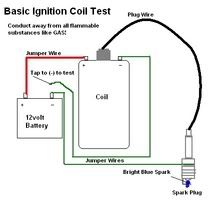If you have the repair manual, you may be able to find a resistance test for the coil (both primary and secondary windings).
Ignition coil theory - Your ignition coil is a big step up transformer. 12volts input .. a few thousand output. One side of the coil is wired to 12v (ignition switched) and the other goes through your points (or electronic equivilents) to ground. When the points close, the 12volts appears across the primary windings of the coil and electromagneticly transfers to the secondary windings providing a high voltyage output to the distributor, which is then distributed to the correct spark plug based on the distributor positon.
To test a coil, start by dissconnecting all wires (you will want to do this test at a bench rather than near any flammable substances like gas. Connect a plug wire that (normally goes to the distributor) onto a spark plug. Strip the end of some jumper wire and wrap it around the threads of the spark plug and put the other end to a good ground source like a battery (-) terminal. Then connect another jumper wire to the positive terminal of the coil to the (+) side of the battery. Lastly, take a third jumper wire and connect it to the (-) side of the coil.
To perform the test, tap the third jumper to ground, when you do a bright blue spark should appear across the spark plug (so don't hold it!). The spark should easily jump a 1/4" and should be nice and fat!
When the engine isn't running (the points are not closed) you WILL measure approximately 12V on both the (+) and (-) side of the coil. What you are seeing is the voltage "bleeding" through from the 12v (+) side to the (-) side of the coil where it is waiting to be grounded. The voltage drop across the coil should be minimal, anything more than a volt or two difference between the (+) and (-) side could mean the coil is bad.




















